ECOLOGY ▪ SCIENCE ▪ EDUCATION
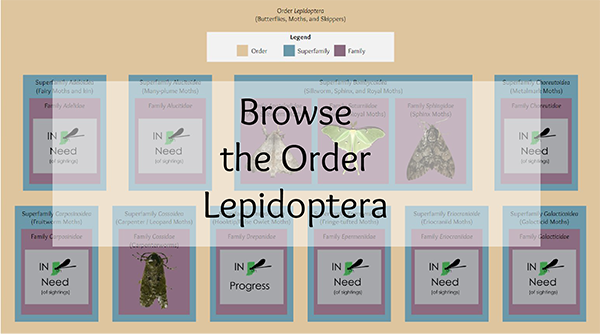
A Sampling of Sightings from the GAINLP
A Sampling of Sightings from the GAINLP
GAIN LP is a statewide community project, which documents the range and life cycles of Indiana’s Lepidoptera while increasing awareness and appreciation of these familiar insects. Through community participation, photographs and data will be used to populate a comprehensive, cost-free resource that will be devoted exclusively to Lepidoptera.

Lepidoptera is one of approximately 30 orders within the zoological class of insects. Order Lepidoptera consists of the insects commonly known as butterflies, moths, and skippers, and it includes some of the most beautiful and ecologically significant insects in Indiana.
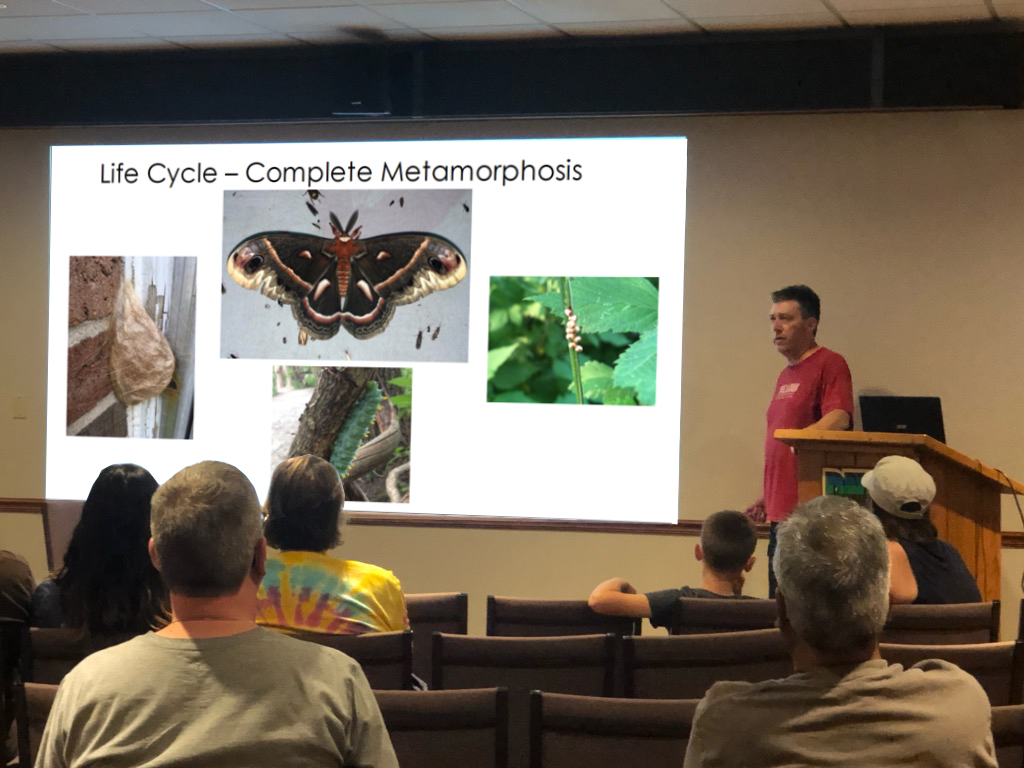
Lepidoptera are distinguished from other insects by the following combined features:
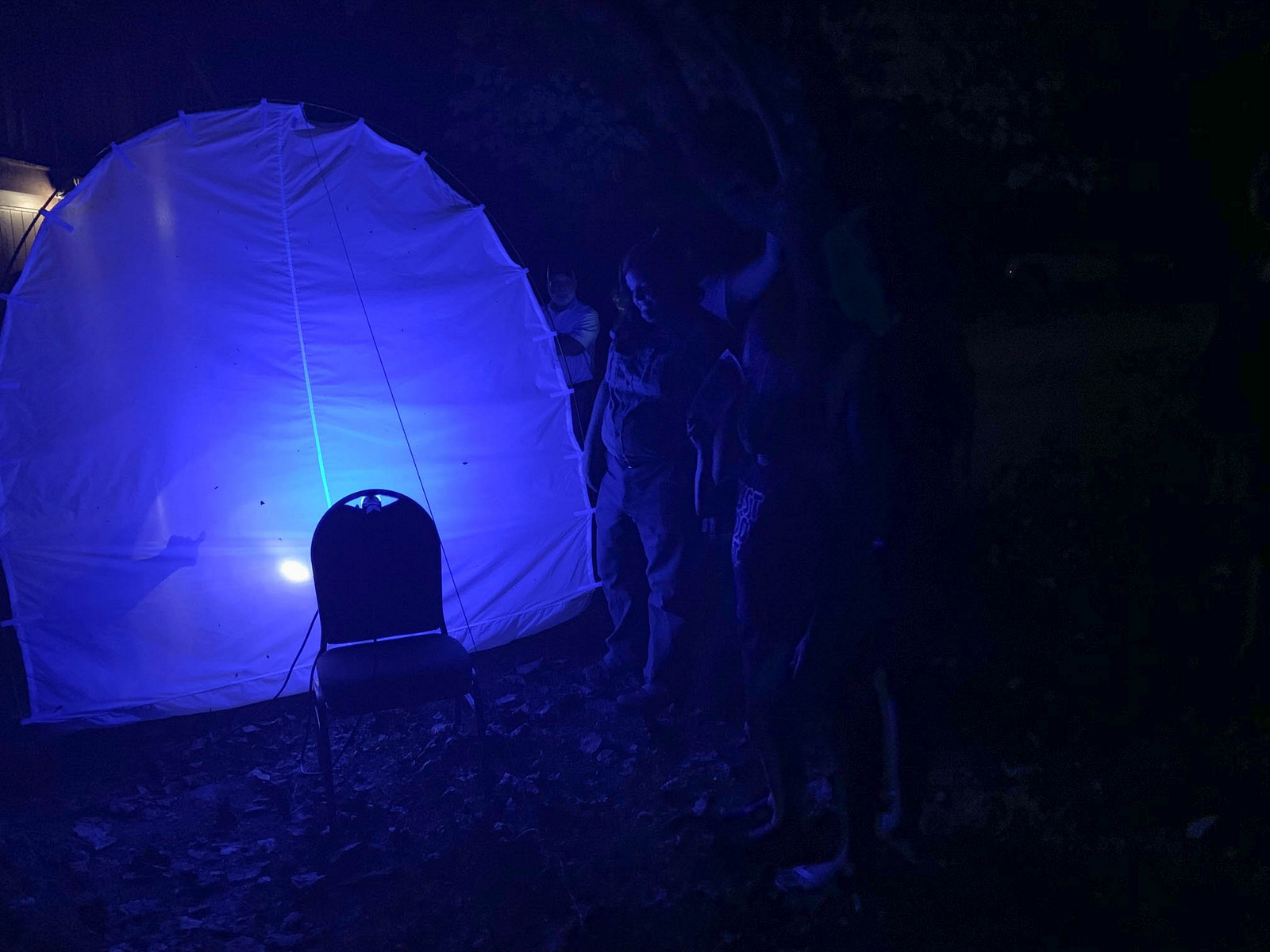
Pages Completed
Number of unique records in the database: 59007
Number of individual field observers: 1441
The success of GAINLP has been completely dependent upon our community involvement and participation. As such, the following individuals are recognized for their contributions to this project.
Photographic and Data Compilers: Megan Bowman, JoAnne Cummings, Grace Danel, Laura Duket, Jeanette Jaskula, Chris Joll, Nancy Marshall, Dan McCord, Karen Wade, and Lisa Williamson
Spelling, Grammar, and Style Editors: Wesley Crouch, Michelle Dunn, Vicky Ebert Stirm, and Debby Vincent.
Field Observers and Photographers: click to view the entire list.
Inspired by discussions about moths in the IN Nature Facebook group, our friend and contributor Jaime Fleming took it upon herself to draw a cecropia moth (Hyalophora cecropia) in pastels on the pavers of her patio. Great job, Jaime!
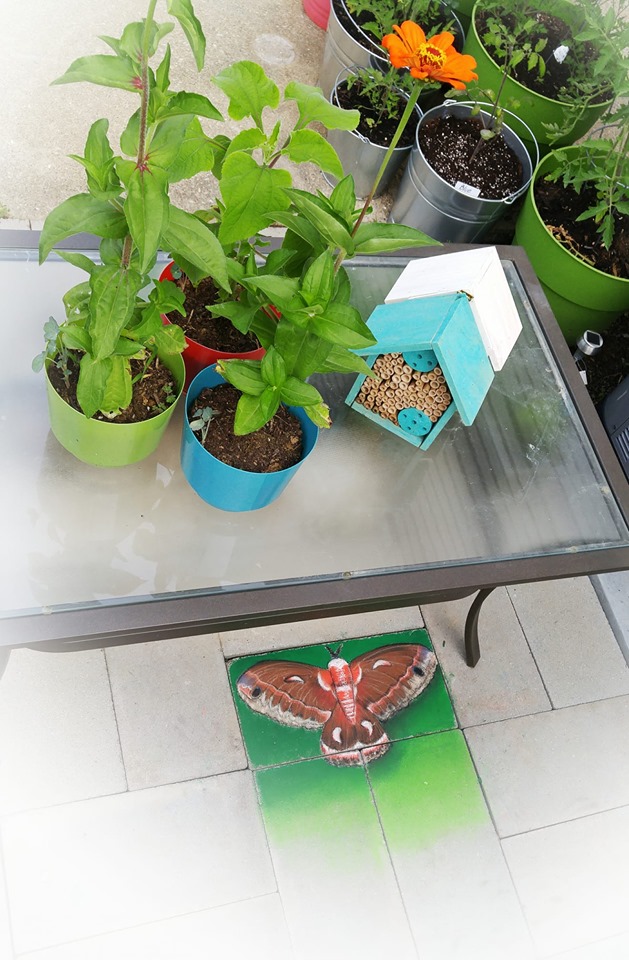
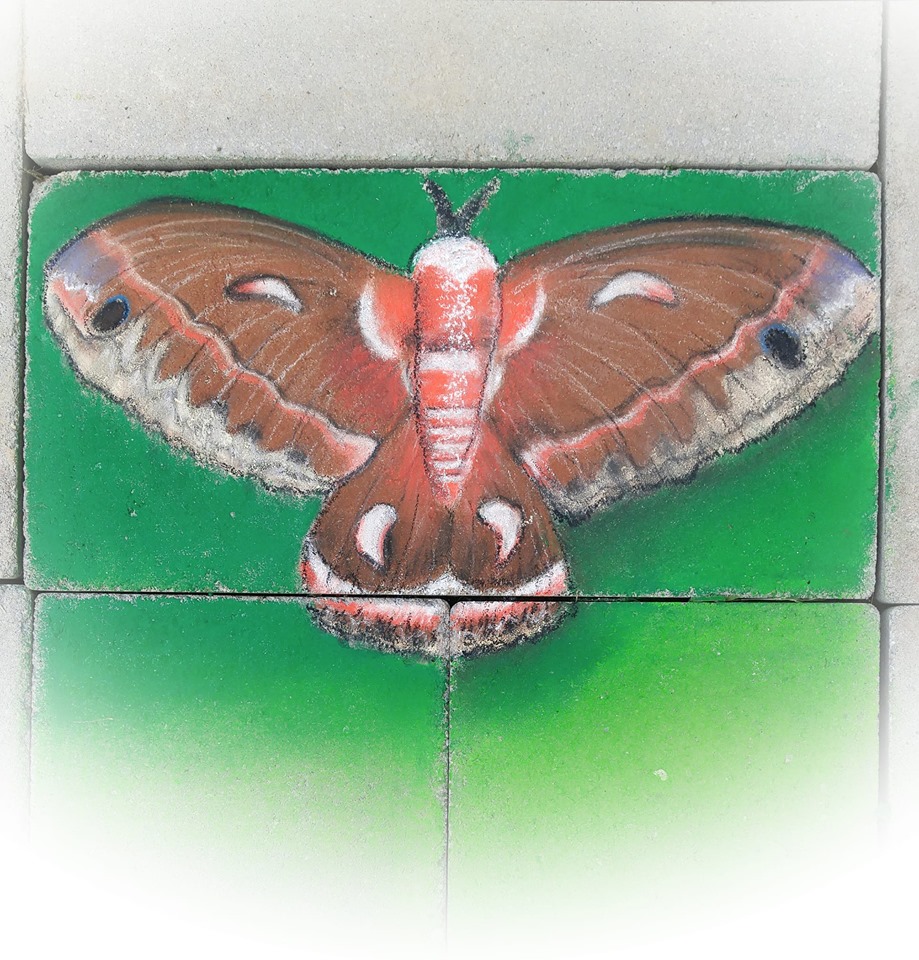
Using all-digital mediums, our friend Melissa Bryant created this amazing showcase of Indiana moths entitled “The Moths of IN Nature.”
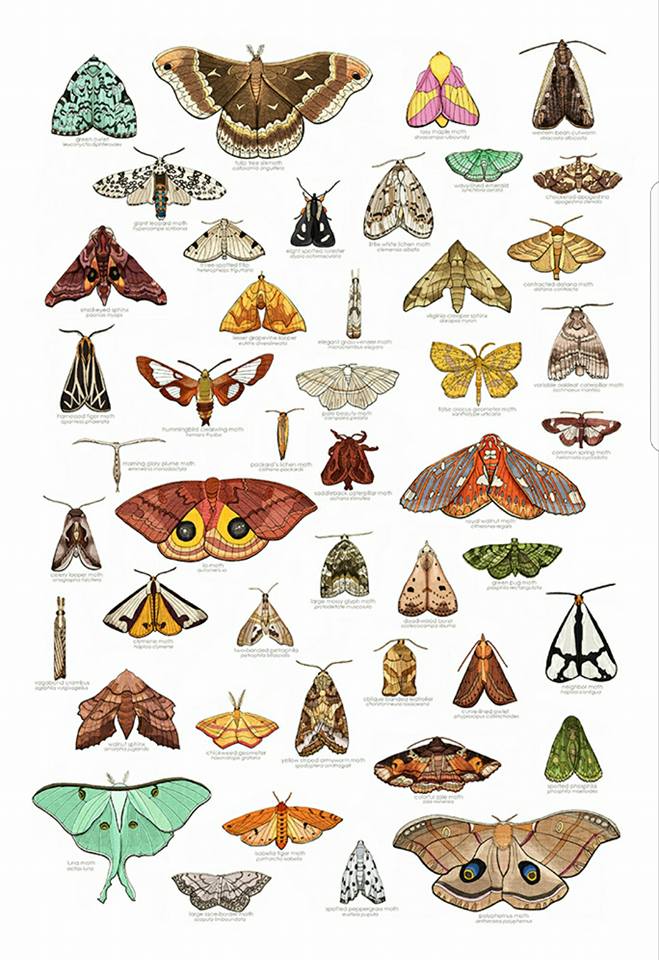
Nature-inspired baking is a favorite of our friend Tracey Setze, who, in July of 2019, baked this butterfly inspired cake. It's too pretty to eat!
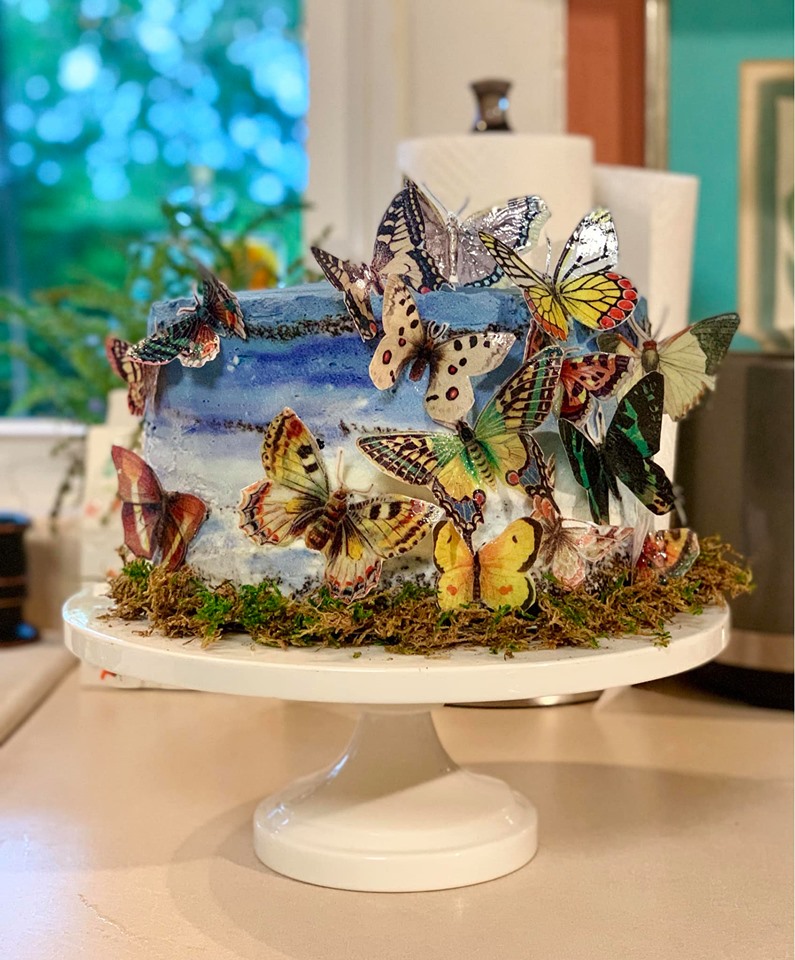
Megan Moss recalled that while working on her biology degree, she used to keep a field sketchbook for her ornithology class. A couple of years ago, her love of insects inspired her to draw the various life stages of Lepidoptera. Megan says that sketching these insects helps her stay connected to nature in the same way that sketching birds did for her while attending Indiana University Kokomo. Great job, Megan!
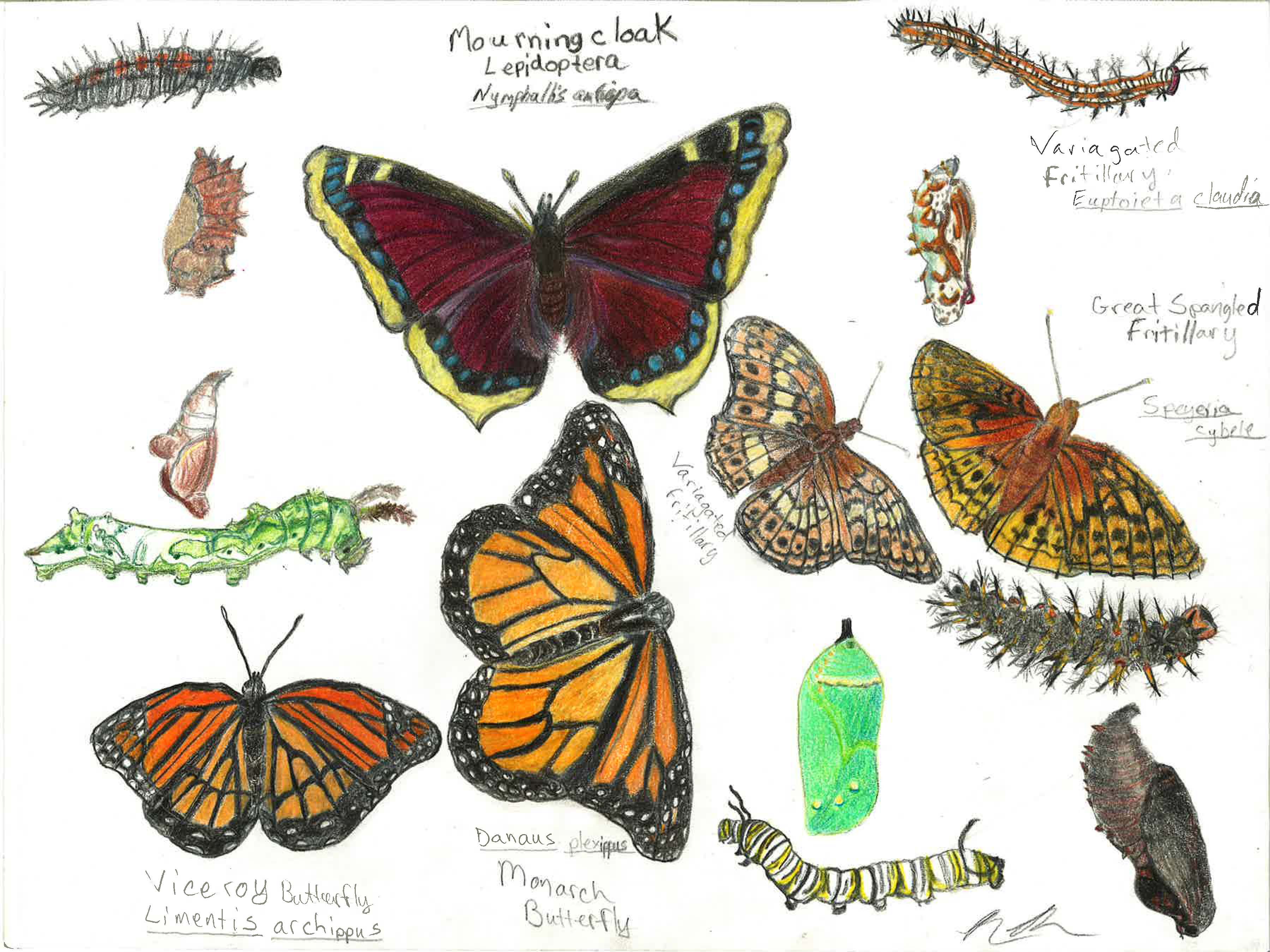
Moths have also inspired poetry, as our friend Philip English penned this lovely tribute in September of 2018
You are the Gem;
And - among others - an Emerald.
You’re Bristly and Abrupt.
You’re Luna, the Little - Obtuse and Unarmed.
You are Spiny and Splendid.
You’re Elegant, Thin and Orange of wing, and Pale-veined, and have been called Common,
Codling, Great and Grateful, Imperial, Ambiguous, and Obscure upon the Carpet: a Bent Line.
You are of the Spring as well as the Fall.
You’re the winters’ Snowberry with Clear wings, and every single summer’s Smokey, Tan Wave.
Most Prominent Major: Black-blotched and White-dotted, White-blotched and Black-spotted, you’re a Small, Yellow-necked Unicorn whose hump is Washed in Red, Double and Angled of Line, Black of rim, Drab and Oblique.
Oh, you – Brother; Youthful Pug, the Begger and Folder of Leaves – a Slow Poke Asteroid on the Wing of an American Bird.
You have become the Zebra with Hitched Arches; filled with contradictions and Confused of color: Yellow, Gray, Gold, Copper, Red, Ochre and Green. You are the Small, Engrailed and fine-lined Alien: Triangle-backed, Two and Five-spotted, Four-barred, Horned, Striped in Gold, Oval-based, and with speckles, a Fervid, Red-fringed Casebearer.
Although Hesitant, you’re a Straight-toothed Quaker: a Wedge-spot of Black. Rustic, Bronzed and indeed, well Connected.
Small and Mossy, your Edging is in White.
Mossy and Large, you’re Black-dashed.
Your Ear is Veiled, but you’ve been Smeared and Renounced as The Scribbler, and called Retarded, but you are Great: we shall call you The Hebrew – The Blazing Star, and you are - upon the good ship Goldenrod - Smooth and Sensitive: the Delightful Stowaway.
Although Closebanded, you are Sharp and Unspotted in the Elder Shoots.
Slippery, you are The Thinker, the Eight-spotted Mayapple with the Reddish Speckled Dart Underwing, found Sallow and Dingy at the Roadside.
Beneath the Dusky Birch you hide - Groundling - in the Verbena and Lobelia, and the Raspberry Bud; you are Implicit in that Striped, Ovate Garden - Wedgeling - with your Yellow-striped Funerary Dagger.
Behold! You are Thoreau’s Beautiful, Pearly, Primrose Wood-nymph and Dark-eyed Pygmy!
Only for you, Great Orange Tiger in the Rusty Painted Milkweed: That Neighbor – the Agreeable, Thin-banded, Pink-legged and Ruddy one - Brown of lines, Scarlet-winged and Immaculate - Lead-colored with Wings bent, perched in the Sycamore : lying in wait under the Common Oak and Woody Hawthorne, with Baltimore’s Glossy, Rotund and Stone-winged Darling, the ever-Charming, Mottled Moon Mother, with Black Zale, The Betrothed, and the Horrid, Black Witch – the False, Sweet and Serene Underwing Widow.
Clouded, and Once-married your Washed out Gypsy - the Moonseed - mourns for Clinton’s Lost Bride.
In a Filigreed Macramé Labyrinth, Exasperated and Orange-tufted, The Astronomer offers Sparkling, Buff-tipped, Oriental Fruit. Shagreened and Graceful, and Crowned in Spun Glass your Feather-edged Waterlily sits, and the Bold Medicine Hag - all Purple-backed and Sooty-winged - whose Stinging Rose is that of a Darker Bee, dangles the White-roped Hawaiian Sweetpotato.
Purple-crested Skiff! Omnivorous Garden Slug!
Masked in White or Black-waved Flannel, and found Transfigured amongst the Pondweed and Poison Hemlock, the Dogwood and the Dogbane, upon the Sod, and found – not unlike the tubular worm - in that Grass.
A Geometer of Chickweed and of Barberry and Juniper, and in the Apple-buds you are: Tufted.
You’ve been Saddled, Bridled, Harnessed, Black-dashed.
Hooded and Hawk-like, you are Rigid.
A lover of Mint, you’re fond of the Rose, the Bluegrass, Straw and Goldenrod; as if a carnivore in the Cabbage, Celery and Parsnip, or Bedstraw, and delight in the Plumes of the Artichoke, the Grape, and Morning-glory.
A being Two colors of honey in the Locust, you nevertheless belong in the Tuliptree and the Ironweed, the Linden bough and Locust Twig, the White Lichen, and Mimosa.
You’re Rosy in the Maple.
For the Sunflowers, the Stalks, European Corn and the Burdock, you are boring.
All Mournful and Blurry Eyed for the Southern Pinecones of Tampa, From your Pink-mask a Carmine Snout searches, for the thief of Stored Grain and Grease, Chocolate, Indian Meal and Mediterranean Flour.
Red-headed and like Granite or Porcelain, a False Crocus in the Snowy White Spring: a Pale Beauty.
Greater and Lesser, you’re a Looper in the Vetch, the Blackberry, and Grapevine, while Unspotted and Black-dotted in the Celery, the Soybeans, and Royal Walnut.
You’re Pearly, yet reduced to a Bird-dropping, you’re both Small as well as Exposed, and Olive-shaded.
You’re white-marked, and a Tufted Great Tabby - Tiger of Virginia - You’re a Wollybear in Yellow, Delicate Diamondback: Subgothic Swordsman; the Twirler - if you will - Scalloped and Swoopwinged.
The Dagger of an American, you are the Dark, Cloaked Marvel; you are Batman: the Dart of the Master.
You are Dimorphic; a Midget Wood-nymph and Sphinx, and yet; you are Small of eye and Modest: an Owlet or Hummingbird who’s Banded.
Waved and Lettered, you’re the Blinded Hermit of the Northern Pines, hiding also in the Elm, the Catalpa, the Fig and the Great Ash, the Pawpaw. You’re there – in the Virginia Creeper, Azalea, Hydrangea, and the Laurel.
Found in the Early Fall in your Eastern or Forest Tent, you’re nevertheless claimed by Alabama, Nevada and Florida, by Carolina in the Salt-marsh, and said to be a Texan, a Canadian, European or Georgian.
You are Grayish and Collared in Pink or Yellow.
You’re Yellow of Chevrons and Shoulders, Oblique and Black, Rufous and Pale, and Pink of your Bands, Dark and Faint of spots, Shaded with Brown (yet Gray) Marked in White, Marbled Green, Cross-lined and Slant-lined in White, One-spotted, Spotted in Yellow, Curved of Tooth and Hooked, and Orange at your tip - you’re Wavy and Bent of Tooth with Lines that Double, or triple.
You’re a Twin Leopard of all sorts of Changeable Spots.
Because of you we remember others: Abbott, Angus, Biden, Clemons, Drexel, Fergusson, Franck, Grote, Hagen, Harris, Henry, Heitzman, Himmelman, Hübner, Isabella, Kent,
Miranda, Morrison, Norman, Radcliffe, Roland, Speyer, Ursula, and -
Above all — you are not
Nondescript.
Inspired by discussions about moths in the IN Nature Facebook group, our friend and contributor Jaime Fleming took it upon herself to draw a cecropia moth (Hyalophora cecropia) in pastels on the pavers of her patio. Great job, Jaime!


Using all-digital mediums, our friend Melissa Bryant created this amazing showcase of Indiana moths entitled “The Moths of IN Nature.”

Nature-inspired baking is a favorite of our friend Tracey Setze, who, in July of 2019, baked this butterfly inspired cake. It's too pretty to eat!

Megan Moss recalled that while working on her biology degree, she used to keep a field sketchbook for her ornithology class. A couple of years ago, her love of insects inspired her to draw the various life stages of Lepidoptera. Megan says that sketching these insects helps her stay connected to nature in the same way that sketching birds did for her while attending Indiana University Kokomo. Great job, Megan!

Moths have also inspired poetry, as our friend Philip English penned this lovely tribute in September of 2018
You are the Gem;
And - among others - an Emerald.
You’re Bristly and Abrupt.
You’re Luna, the Little - Obtuse and Unarmed.
You are Spiny and Splendid.
You’re Elegant, Thin and Orange of wing, and Pale-veined, and have been called Common,
Codling, Great and Grateful, Imperial, Ambiguous, and Obscure upon the Carpet: a Bent Line.
You are of the Spring as well as the Fall.
You’re the winters’ Snowberry with Clear wings, and every single summer’s Smokey, Tan Wave.
Most Prominent Major: Black-blotched and White-dotted, White-blotched and Black-spotted, you’re a Small, Yellow-necked Unicorn whose hump is Washed in Red, Double and Angled of Line, Black of rim, Drab and Oblique.
Oh, you – Brother; Youthful Pug, the Begger and Folder of Leaves – a Slow Poke Asteroid on the Wing of an American Bird.
You have become the Zebra with Hitched Arches; filled with contradictions and Confused of color: Yellow, Gray, Gold, Copper, Red, Ochre and Green. You are the Small, Engrailed and fine-lined Alien: Triangle-backed, Two and Five-spotted, Four-barred, Horned, Striped in Gold, Oval-based, and with speckles, a Fervid, Red-fringed Casebearer.
Although Hesitant, you’re a Straight-toothed Quaker: a Wedge-spot of Black. Rustic, Bronzed and indeed, well Connected.
Small and Mossy, your Edging is in White.
Mossy and Large, you’re Black-dashed.
Your Ear is Veiled, but you’ve been Smeared and Renounced as The Scribbler, and called Retarded, but you are Great: we shall call you The Hebrew – The Blazing Star, and you are - upon the good ship Goldenrod - Smooth and Sensitive: the Delightful Stowaway.
Although Closebanded, you are Sharp and Unspotted in the Elder Shoots.
Slippery, you are The Thinker, the Eight-spotted Mayapple with the Reddish Speckled Dart Underwing, found Sallow and Dingy at the Roadside.
Beneath the Dusky Birch you hide - Groundling - in the Verbena and Lobelia, and the Raspberry Bud; you are Implicit in that Striped, Ovate Garden - Wedgeling - with your Yellow-striped Funerary Dagger.
Behold! You are Thoreau’s Beautiful, Pearly, Primrose Wood-nymph and Dark-eyed Pygmy!
Only for you, Great Orange Tiger in the Rusty Painted Milkweed: That Neighbor – the Agreeable, Thin-banded, Pink-legged and Ruddy one - Brown of lines, Scarlet-winged and Immaculate - Lead-colored with Wings bent, perched in the Sycamore : lying in wait under the Common Oak and Woody Hawthorne, with Baltimore’s Glossy, Rotund and Stone-winged Darling, the ever-Charming, Mottled Moon Mother, with Black Zale, The Betrothed, and the Horrid, Black Witch – the False, Sweet and Serene Underwing Widow.
Clouded, and Once-married your Washed out Gypsy - the Moonseed - mourns for Clinton’s Lost Bride.
In a Filigreed Macramé Labyrinth, Exasperated and Orange-tufted, The Astronomer offers Sparkling, Buff-tipped, Oriental Fruit. Shagreened and Graceful, and Crowned in Spun Glass your Feather-edged Waterlily sits, and the Bold Medicine Hag - all Purple-backed and Sooty-winged - whose Stinging Rose is that of a Darker Bee, dangles the White-roped Hawaiian Sweetpotato.
Purple-crested Skiff! Omnivorous Garden Slug!
Masked in White or Black-waved Flannel, and found Transfigured amongst the Pondweed and Poison Hemlock, the Dogwood and the Dogbane, upon the Sod, and found – not unlike the tubular worm - in that Grass.
A Geometer of Chickweed and of Barberry and Juniper, and in the Apple-buds you are: Tufted.
You’ve been Saddled, Bridled, Harnessed, Black-dashed.
Hooded and Hawk-like, you are Rigid.
A lover of Mint, you’re fond of the Rose, the Bluegrass, Straw and Goldenrod; as if a carnivore in the Cabbage, Celery and Parsnip, or Bedstraw, and delight in the Plumes of the Artichoke, the Grape, and Morning-glory.
A being Two colors of honey in the Locust, you nevertheless belong in the Tuliptree and the Ironweed, the Linden bough and Locust Twig, the White Lichen, and Mimosa.
You’re Rosy in the Maple.
For the Sunflowers, the Stalks, European Corn and the Burdock, you are boring.
All Mournful and Blurry Eyed for the Southern Pinecones of Tampa, From your Pink-mask a Carmine Snout searches, for the thief of Stored Grain and Grease, Chocolate, Indian Meal and Mediterranean Flour.
Red-headed and like Granite or Porcelain, a False Crocus in the Snowy White Spring: a Pale Beauty.
Greater and Lesser, you’re a Looper in the Vetch, the Blackberry, and Grapevine, while Unspotted and Black-dotted in the Celery, the Soybeans, and Royal Walnut.
You’re Pearly, yet reduced to a Bird-dropping, you’re both Small as well as Exposed, and Olive-shaded.
You’re white-marked, and a Tufted Great Tabby - Tiger of Virginia - You’re a Wollybear in Yellow, Delicate Diamondback: Subgothic Swordsman; the Twirler - if you will - Scalloped and Swoopwinged.
The Dagger of an American, you are the Dark, Cloaked Marvel; you are Batman: the Dart of the Master.
You are Dimorphic; a Midget Wood-nymph and Sphinx, and yet; you are Small of eye and Modest: an Owlet or Hummingbird who’s Banded.
Waved and Lettered, you’re the Blinded Hermit of the Northern Pines, hiding also in the Elm, the Catalpa, the Fig and the Great Ash, the Pawpaw. You’re there – in the Virginia Creeper, Azalea, Hydrangea, and the Laurel.
Found in the Early Fall in your Eastern or Forest Tent, you’re nevertheless claimed by Alabama, Nevada and Florida, by Carolina in the Salt-marsh, and said to be a Texan, a Canadian, European or Georgian.
You are Grayish and Collared in Pink or Yellow.
You’re Yellow of Chevrons and Shoulders, Oblique and Black, Rufous and Pale, and Pink of your Bands, Dark and Faint of spots, Shaded with Brown (yet Gray) Marked in White, Marbled Green, Cross-lined and Slant-lined in White, One-spotted, Spotted in Yellow, Curved of Tooth and Hooked, and Orange at your tip - you’re Wavy and Bent of Tooth with Lines that Double, or triple.
You’re a Twin Leopard of all sorts of Changeable Spots.
Because of you we remember others: Abbott, Angus, Biden, Clemons, Drexel, Fergusson, Franck, Grote, Hagen, Harris, Henry, Heitzman, Himmelman, Hübner, Isabella, Kent,
Miranda, Morrison, Norman, Radcliffe, Roland, Speyer, Ursula, and -
Above all — you are not
Nondescript.
The following resources were used as references for numerous Lepidoptera webpages on this website. Additional sources are cited when applicable on individual pages:
Belth J. 2013. Butterflies of Indiana. Bloomington (IN): Indiana University Press.
[BOLD] Barcode of Life Data Systems v4. 2019. [Accessed: October 26, 2019]. http://www.boldsystems.org/
Borror D. 1988. Dictionary of word roots and combining forms. Mountain View (CA): Mayfield Pub. Co.
Bouseman J, Sternburg J. 2001. Field guide to butterflies of Illinois. Champaign (IL): Illinois Natural History Survey.
Bouseman J, Sternburg J. 2002. Field guide to silkmoths of Illinois. Champaign (IL): Illinois Natural History Survey.
Brock J, Kaufman K, Bowers R, Bowers N, Kaufman L. 2006. Kaufman field guide to butterflies of North America. New York (NY): Houghton Mifflin.
Bugguide.net. [accessed 2018 May 17]. https://bugguide.net
Butterflies and moths of North America. 2018. [accessed 2018 May 17]. https://www.butterfliesandmoths.org
Encyclopedia of Life. 2018. [accessed 20 Oct 2018]. www.eol.org
Global Biodiversity Information Facility. 2018. [accessed 20 August 2018]. https://www.gbif.org
Integrated Taxonomic Information System. 2018 [accessed 2018 Oct 21]. https://www.itis.gov
Lepidoptera Barcode of Life. 2018. [accessed 2018 Jul 7]. http://www.lepbarcoding.org
Natural History Museum. 2019. [accessed 2019 Jul 4]. https://www.nhm.ac.uk/our-science/data/lepindex/lepindex/
NatureServe. 2018. [Accessed: October 21, 2018]. http://explorer.natureserve.org
Shropshire KJ. webmoths.xls. [accessed 2014 Jul]. http://canr.udel.edu/faculty/tallamy-doug/new_xls/webplants.xls
Tuskes P, Collins M, Tuttle J. 1996. The Wild Silk Moths of North America. Ithaca (NY): Cornell University Press.
Umbers K, Lehtonen J, Mappes J. 2015. Deimatic displays. Current Biology 25:R58-R59. [accessed 2021 Feb 20]. https://www.cell.com/current-biology/pdf/S0960-9822(14)01438-9.pdf
Wagner D. 2010. Caterpillars of Eastern North America. Princeton (NJ): Princeton University Press.
Wisconsinbutterflies.org. 2018.[accessed 2018 May 17]. https://wisconsinbutterflies.org